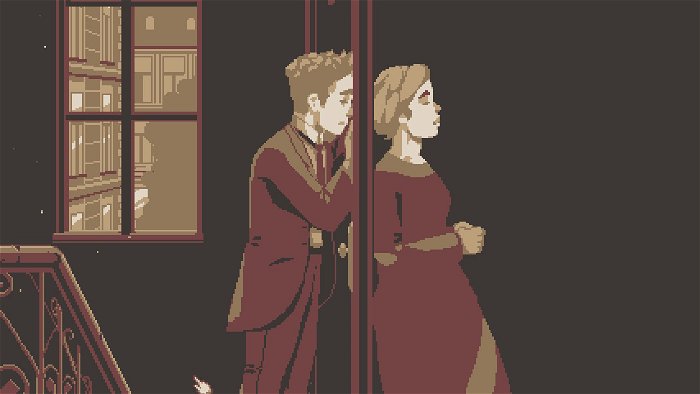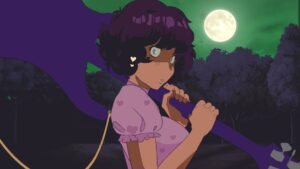I find that there is a certain kind of joy that comes with discovering a game that otherwise I would have missed but, somehow, ended up playing anyway. This feeling is naturally amplified when the game in question turns out to actually be good — I’m quite happy to say, The Lion’s Song is not only good, it just might be new favourite point and click game of all time.
Right off the bat, I was drawn to The Lion’s Song solely due to its striking art direction. I’m a huge fan of contemporary pixel art and The Lion’s Song’s monochromatic aesthetics were something I found immediately appealing. In other words, I totally judged a book by its pixelated halftone cover. Little did I know that what lay inside was a deep and rich narrative spread across 4 episodes, all intertwined together in a natural and cohesive story full of heart and relatable characters in an otherwise, unrelatable but beautiful depiction of Vienna in the early 20th Century.

Unlike most point and click adventure games or visual novels, which I find generally use fantastical themes as its central crux or hook, The Lion’s Song, instead, focuses on a more realistic story. The game follows the lives of artists during one of the great art revolutions of the world that gave birth to many different styles. This time period is especially interesting, as it was during this era, that the popularity of Salons, institutions that fostered and garnered groups of artists in mostly, European countries (first being popularized in France around the 17th century) reached its climax. This setting is later explored in the second episode of the game.

The first episode opens with players being introduced to the character, Wilma, a famous up-and-coming composer and musician, along with her companion, Arthur, a ruthlessly tough but understanding mentor who is, perhaps, a little more than a friend. In order to prepare for an upcoming show, Arthur essentially forces Wilma to vacate to his secluded cabin, where she can be in isolation and free from the distractions of the mundane and everyday hubbub.
Without diving too deep into the rest of the episode, I’ll just say that the game does an exceptional job of creating this feeling of isolation along with the stresses that come from having to deal with deadlines and the anxieties associated with the creative process, such as not feeling happy with ones’ work. As someone who himself has dabbled in the arts, I found this aspect of the game very relatable and thankfully, the themes present in the first episode carry over to the other three and manifest in diverse and more interesting ways. The creative process is applicable to many mediums of art and The Lion’s Song does a stellar job in portraying the ups and downs of ideation, concept and final execution, while in tandem, exploring the relationships and inner machinations of each individual character that the player controls throughout the episodes.

The Switch version of the game features all 4 episodes in one convenient package and thanks to the large screen, makes it a perfect fit for fans of narrative heavy titles. Although I don’t have the actual times, I feel as though each episode took me around 40 mins to an hour to finish, which I believe to be a great fit for on-the-go players as each episode felt like reading a short story or novella.
Of course, The Lion’s Song is a video game and not strictly a written work, meaning players have the ability to interact with the game world around them. All of the interactions are done through the use of the left-stick or directional buttons and are pretty much your standard point-and-click fare, however, the visual novel aspects of the game are what I found to be the best elements within The Lion’s Song, especially in regards to choice.
Each choice felt impactful and well implemented, almost akin to a good RPG such as the Witcher series, in terms of branching narrative choices that vastly alter the final outcome of the episode — thankfully, Mi’pu’mi Games have made it easy for players to redo their actions in particularly decisive scenes. Once a chapter or episode is complete, Lion’s Song gives players’ a glimpse into what other players chose along with a percentage of how many of those players went with the same action as yourself, finally giving players the ability to revisit each section, if so desired, without compromising the progress made prior.
Unsurprisingly, the sound design in The Lion’s Song is also, top-notch. The game seems to deliberately use a limited amount of sounds and no real background music to speak of. Instead, it relied on the ambience of everyday sound effects, punctuated with sections featuring truly well-realized tracks, spread just far enough between each other making it always feel welcome and well deployed.
At the end of the day, The Lion’s Song is most likely going to be a niche title, making it difficult to recommend to everyone. However, players that enjoy a strong narrative in their games or those who appreciate the arts, The Lion’s Song is a must play and feels right at home on the Nintendo Switch. The Lion’s Song is a rare game that perfectly blends together classic adventure game and visual novel mechanics, while conveying a truly unique and memorable story, elevating it above the rest within its genre.





